Changes in PRIMAP-hist v2.6.1_final compared to v2.6_final for Tonga
2025-03-19
Johannes Gütschow
Change analysis for Tonga for PRIMAP-hist v2.6.1_final compared to v2.6_final
Overview over emissions by sector and gas
The following figures show the aggregate national total emissions excluding LULUCF AR6GWP100 for the country reported priority scenario. The dotted linesshow the v2.6_final data.
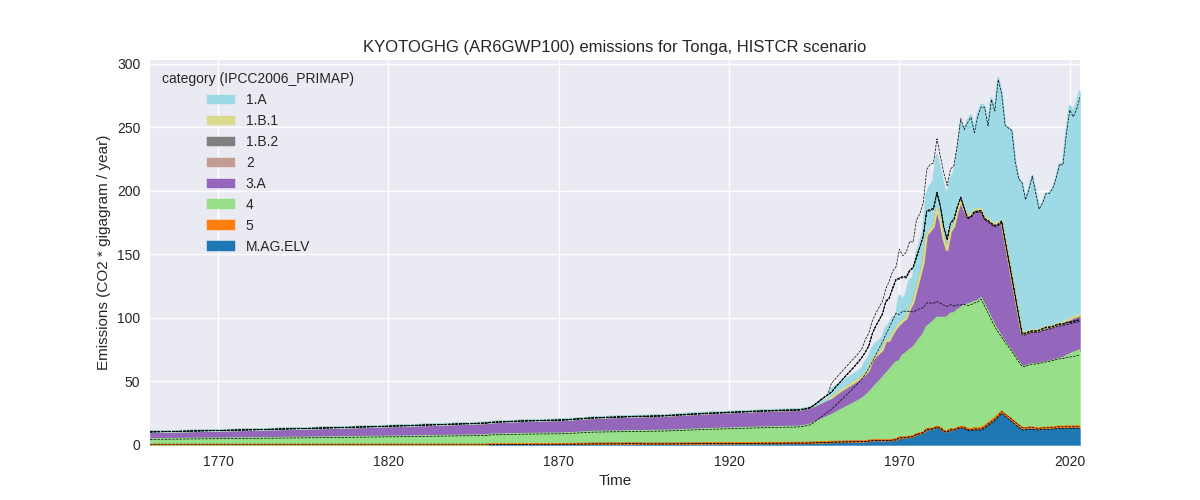
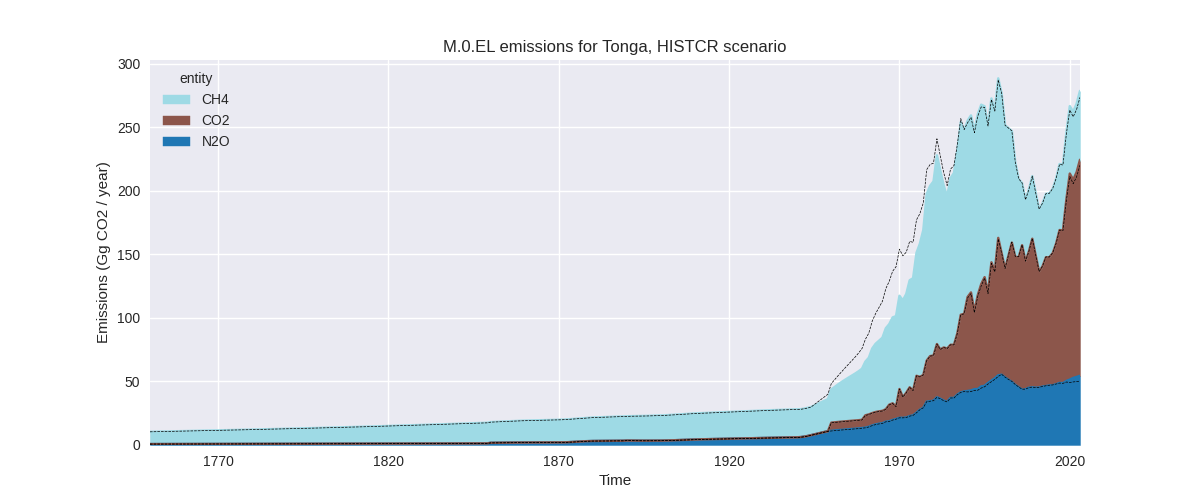
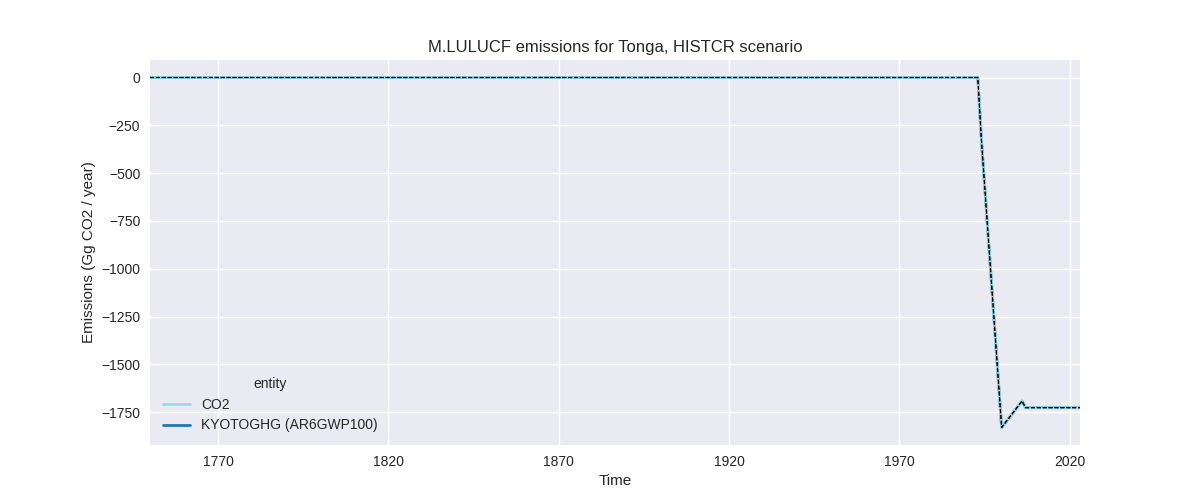
The following figures show the aggregate national total emissions excluding LULUCF AR6GWP100 for the third party priority scenario. The dotted linesshow the v2.6_final data.
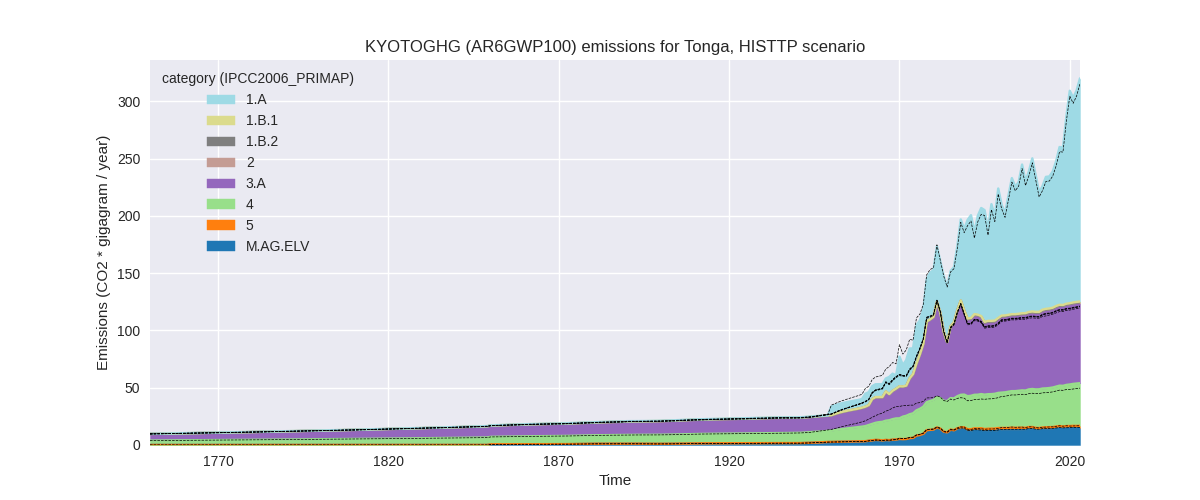
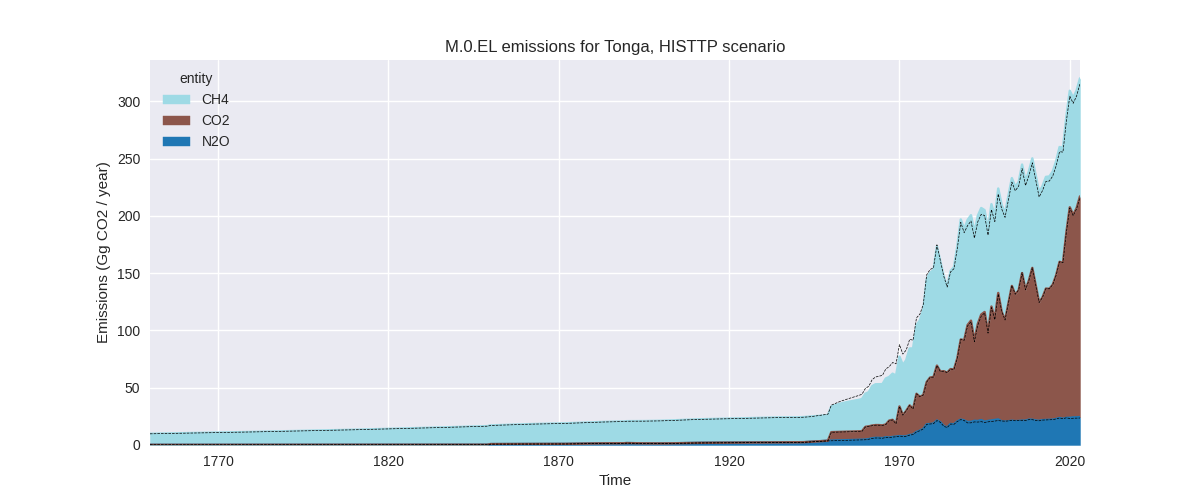
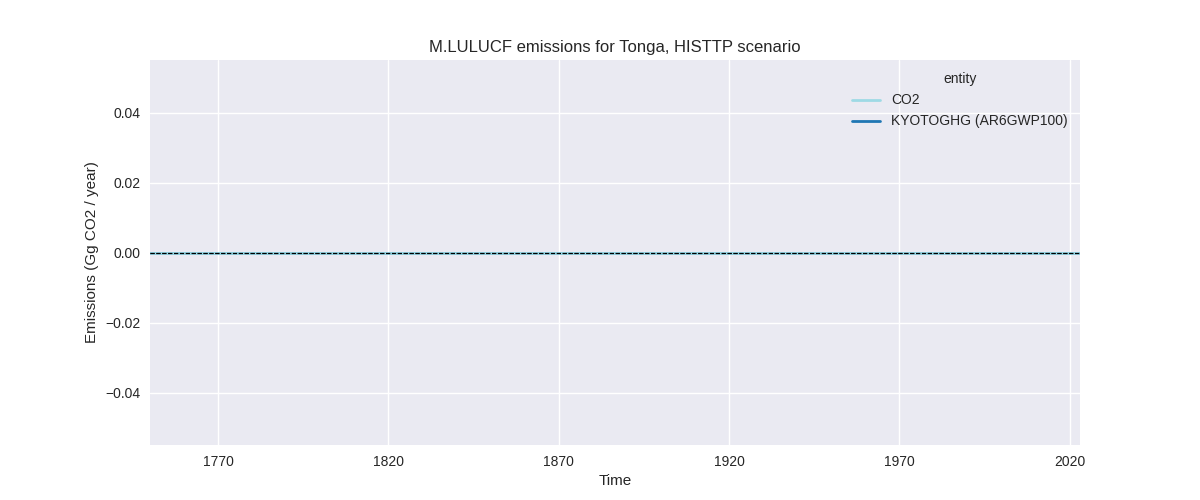
Overview over changes
In the country reported priority scenario we have the following changes for aggregate Kyoto GHG and national total emissions excluding LULUCF (M.0.EL):
- Emissions in 2023 have changed by 1.8%% (5.05 Gg CO2 / year)
- Emissions in 1990-2023 have changed by 0.4%% (0.87 Gg CO2 / year)
In the third party priority scenario we have the following changes for aggregate Kyoto GHG and national total emissions excluding LULUCF (M.0.EL):
- Emissions in 2023 have changed by 1.5%% (4.67 Gg CO2 / year)
- Emissions in 1990-2023 have changed by 1.8%% (4.24 Gg CO2 / year)
Most important changes per scenario and time frame
In the country reported priority scenario the following sector-gas combinations have the highest absolute impact on national total KyotoGHG (AR6GWP100) emissions in 2023 (top 5):
- 1: 4, N2O with 3.55 Gg CO2 / year (11.5%)
- 2: 1.A, CH4 with 1.01 Gg CO2 / year (26.0%)
- 3: 1.A, N2O with 0.59 Gg CO2 / year (44.2%)
- 4: 5, N2O with 0.40 Gg CO2 / year (28.5%)
- 5: M.AG.ELV, N2O with -0.28 Gg CO2 / year (-2.3%)
In the country reported priority scenario the following sector-gas combinations have the highest absolute impact on national total KyotoGHG (AR6GWP100) emissions in 1990-2023 (top 5):
- 1: 4, N2O with 0.34 Gg CO2 / year (1.2%)
- 2: 1.B.1, CH4 with 0.21 Gg CO2 / year (49.1%)
- 3: 1.A, N2O with 0.19 Gg CO2 / year (15.9%)
- 4: 1.A, CH4 with 0.11 Gg CO2 / year (3.4%)
- 5: 5, N2O with 0.05 Gg CO2 / year (3.6%)
In the third party priority scenario the following sector-gas combinations have the highest absolute impact on national total KyotoGHG (AR6GWP100) emissions in 2023 (top 5):
- 1: 4, CH4 with 4.22 Gg CO2 / year (13.3%)
- 2: 1.A, N2O with 0.59 Gg CO2 / year (44.2%)
- 3: 5, N2O with 0.40 Gg CO2 / year (28.5%)
- 4: 3.A, CH4 with -0.40 Gg CO2 / year (-0.6%)
- 5: M.AG.ELV, N2O with -0.35 Gg CO2 / year (-2.3%)
In the third party priority scenario the following sector-gas combinations have the highest absolute impact on national total KyotoGHG (AR6GWP100) emissions in 1990-2023 (top 5):
- 1: 4, CH4 with 3.95 Gg CO2 / year (14.3%)
- 2: 1.B.1, CH4 with 0.21 Gg CO2 / year (49.1%)
- 3: 1.A, N2O with 0.19 Gg CO2 / year (15.9%)
- 4: M.AG.ELV, CH4 with -0.16 Gg CO2 / year (-81.5%)
- 5: 5, N2O with 0.05 Gg CO2 / year (3.6%)
Notes on data changes
Here we list notes explaining important emissions changes for the country.
- No new country reported data has been included. Country reported data covers only 1994, 2000, and 2006 thus the third party data has a high influence on the CR time-series. Many sectors are not covered by country reported data and third party data is used directly. Changes in the CR time-series are small in terms of total emissions and come from updated third party data (EDGAR, FAO).
- In the TP scenario the changes are for similar sectors with the addition of an increase in waste CH4 emissions from EDGAR data.
- pre-1990 emissions are lower because the EDGAR waste CH4 time-series have changed pre-1990 and pre-1980 emissions are now lower while post-1980 emissions are lower than in the last EDGAR version.
Changes by sector and gas
For each scenario and time frame the changes are displayed for all individual sectors and all individual gases. In the sector plot we use aggregate Kyoto GHGs in AR6GWP100. In the gas plot we usenational total emissions without LULUCF.
country reported scenario
2023
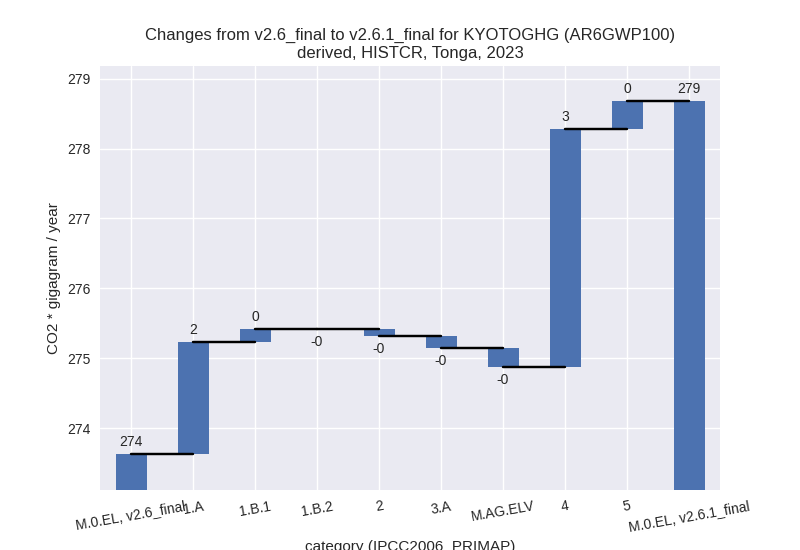
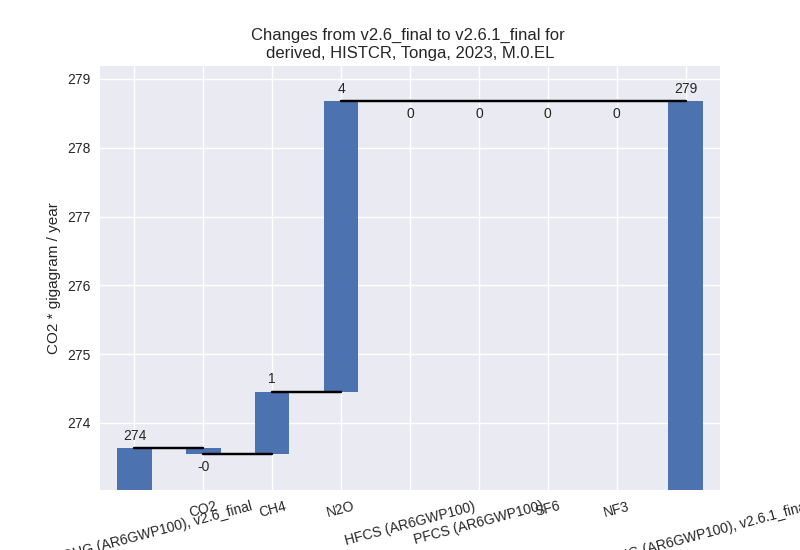
1990-2023
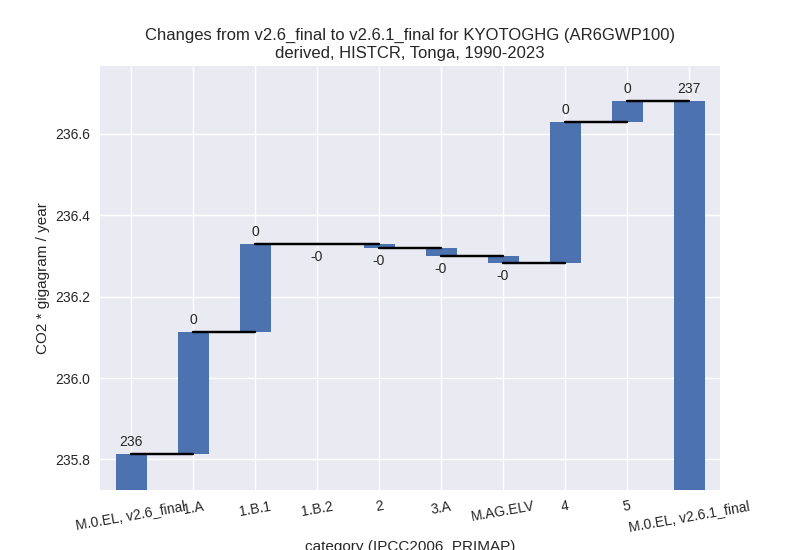
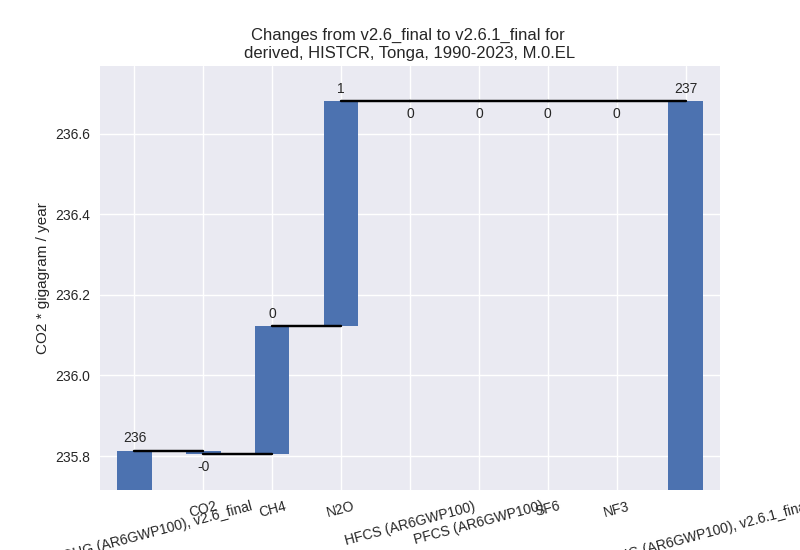
third party scenario
2023
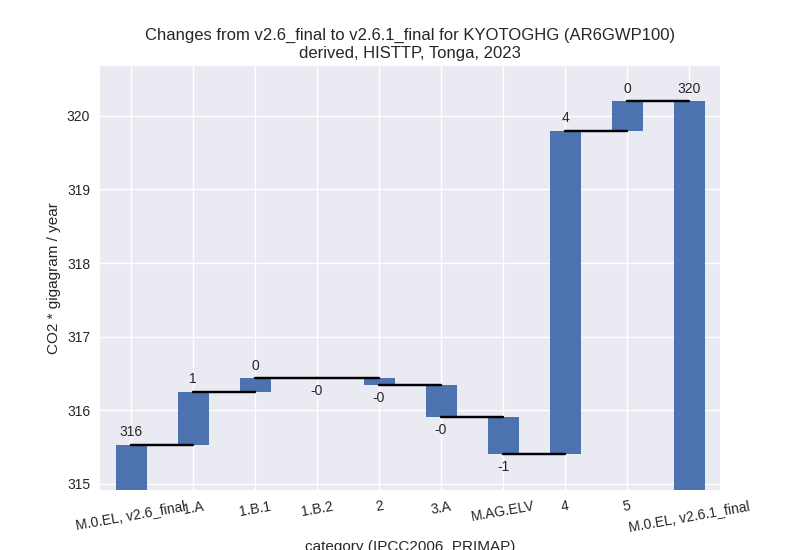
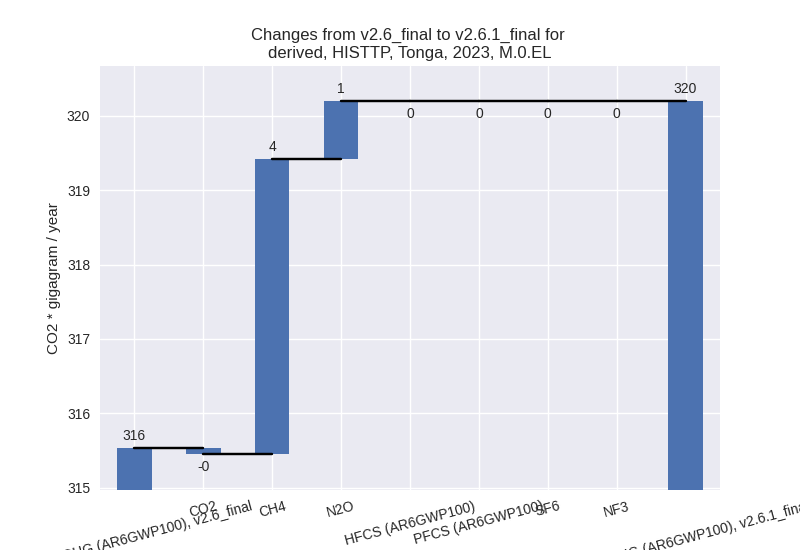
1990-2023
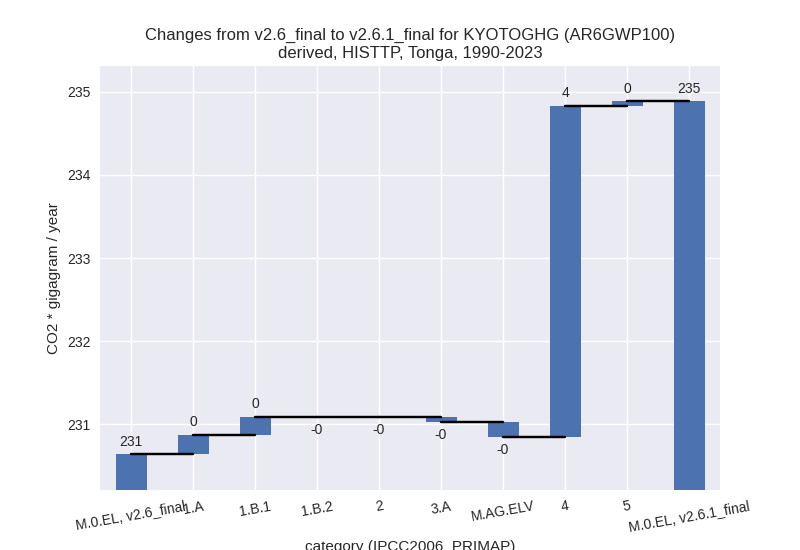
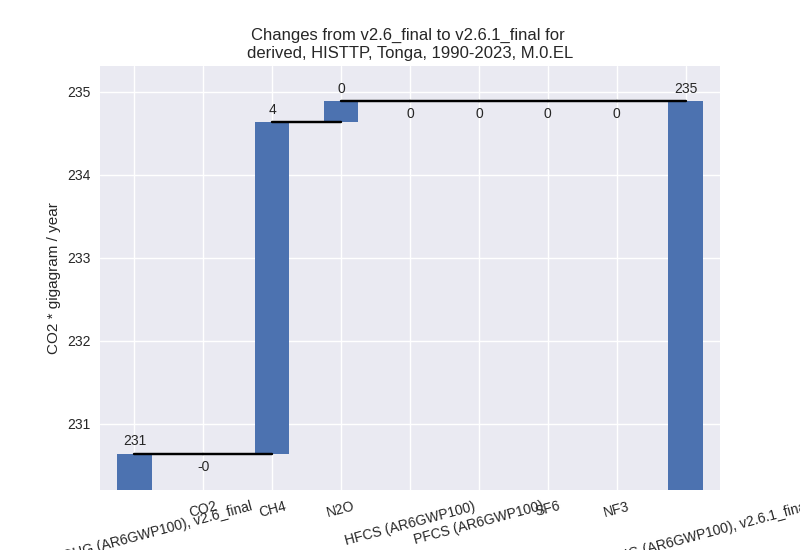
Detailed changes for the scenarios:
country reported scenario (HISTCR):
Most important changes per time frame
For 2023 the following sector-gas combinations have the highest absolute impact on national total KyotoGHG (AR6GWP100) emissions in 2023 (top 5):
- 1: 4, N2O with 3.55 Gg CO2 / year (11.5%)
- 2: 1.A, CH4 with 1.01 Gg CO2 / year (26.0%)
- 3: 1.A, N2O with 0.59 Gg CO2 / year (44.2%)
- 4: 5, N2O with 0.40 Gg CO2 / year (28.5%)
- 5: M.AG.ELV, N2O with -0.28 Gg CO2 / year (-2.3%)
For 1990-2023 the following sector-gas combinations have the highest absolute impact on national total KyotoGHG (AR6GWP100) emissions in 1990-2023 (top 5):
- 1: 4, N2O with 0.34 Gg CO2 / year (1.2%)
- 2: 1.B.1, CH4 with 0.21 Gg CO2 / year (49.1%)
- 3: 1.A, N2O with 0.19 Gg CO2 / year (15.9%)
- 4: 1.A, CH4 with 0.11 Gg CO2 / year (3.4%)
- 5: 5, N2O with 0.05 Gg CO2 / year (3.6%)
Changes in the main sectors for aggregate KyotoGHG (AR6GWP100) are
- 1: Total sectoral emissions in 2022 are 167.92 Gg CO2 / year which is 62.5% of M.0.EL emissions. 2023 Emissions have changed by 1.0% (1.78 Gg CO2 / year). 1990-2023 Emissions have changed by 0.5% (0.52 Gg CO2 / year).
- 2: Total sectoral emissions in 2022 are 1.15 Gg CO2
/ year which is 0.4% of M.0.EL emissions. 2023 Emissions have changed by
-7.4% (-0.09 Gg CO2 / year).
1990-2023 Emissions have changed by -0.7% (-0.01 Gg CO2 / year). For 2023 the
changes per gas
are:
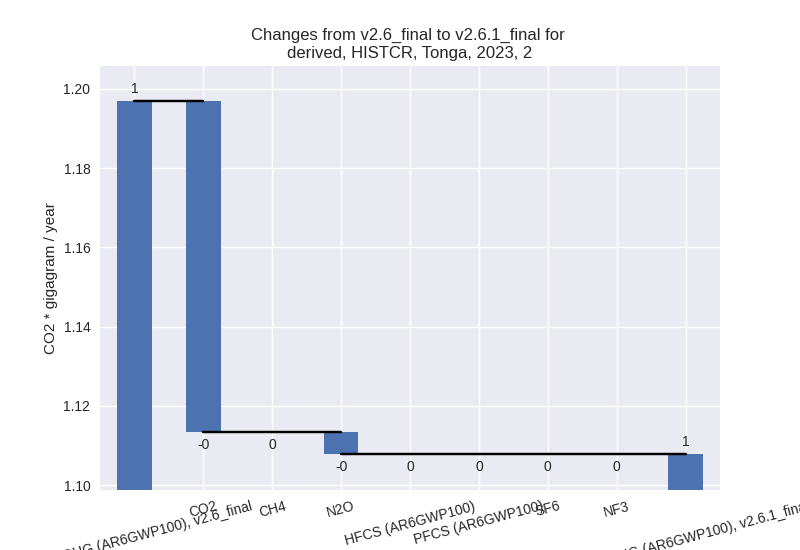
- M.AG: Total sectoral emissions in 2022 are 38.95 Gg CO2 / year which is 14.5% of M.0.EL emissions. 2023 Emissions have changed by -1.1% (-0.45 Gg CO2 / year). 1990-2023 Emissions have changed by -0.1% (-0.04 Gg CO2 / year).
- 4: Total sectoral emissions in 2022 are 58.77 Gg
CO2 / year which is 21.9% of M.0.EL emissions. 2023 Emissions have
changed by 6.0% (3.40 Gg CO2 /
year). 1990-2023 Emissions have changed by 0.5% (0.35 Gg CO2 / year). For 2023 the
changes per gas
are:
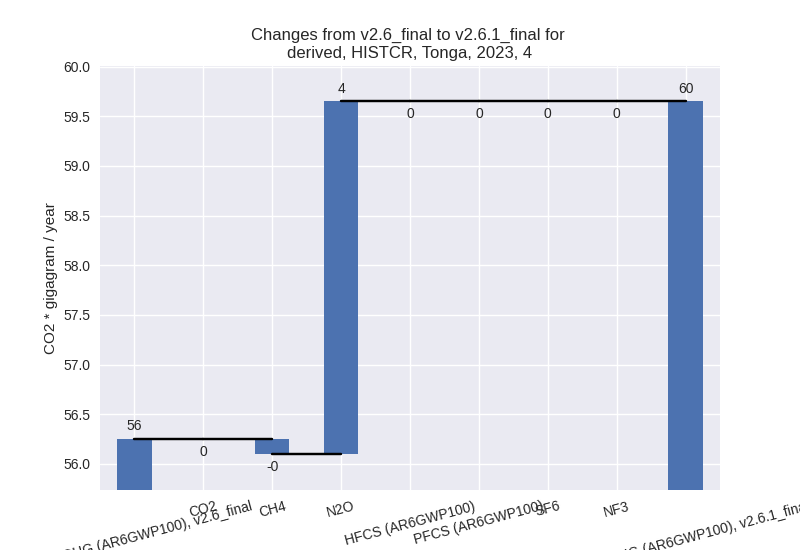
- 5: Total sectoral emissions in 2022 are 1.77 Gg CO2
/ year which is 0.7% of M.0.EL emissions. 2023 Emissions have changed by
28.5% (0.40 Gg CO2 / year).
1990-2023 Emissions have changed by 3.6% (0.05 Gg CO2 / year). For 2023 the
changes per gas
are:
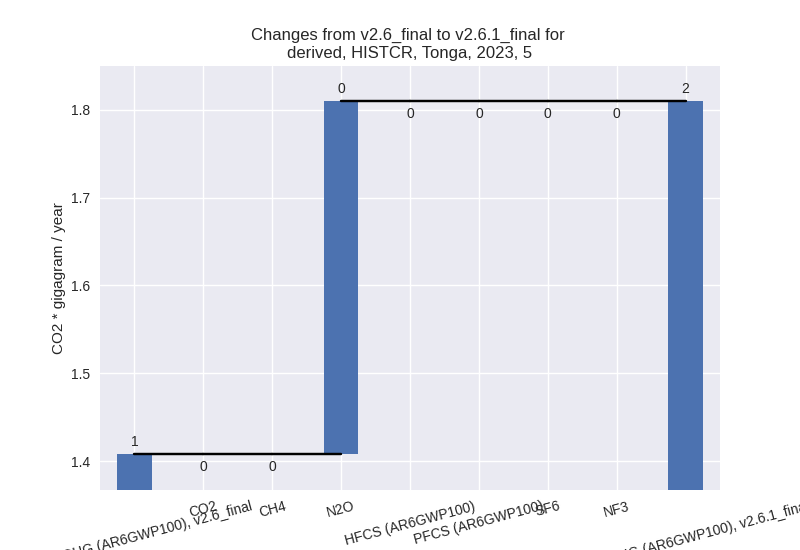
For 1990-2023 the changes per gas are:
third party scenario (HISTTP):
Most important changes per time frame
For 2023 the following sector-gas combinations have the highest absolute impact on national total KyotoGHG (AR6GWP100) emissions in 2023 (top 5):
- 1: 4, CH4 with 4.22 Gg CO2 / year (13.3%)
- 2: 1.A, N2O with 0.59 Gg CO2 / year (44.2%)
- 3: 5, N2O with 0.40 Gg CO2 / year (28.5%)
- 4: 3.A, CH4 with -0.40 Gg CO2 / year (-0.6%)
- 5: M.AG.ELV, N2O with -0.35 Gg CO2 / year (-2.3%)
For 1990-2023 the following sector-gas combinations have the highest absolute impact on national total KyotoGHG (AR6GWP100) emissions in 1990-2023 (top 5):
- 1: 4, CH4 with 3.95 Gg CO2 / year (14.3%)
- 2: 1.B.1, CH4 with 0.21 Gg CO2 / year (49.1%)
- 3: 1.A, N2O with 0.19 Gg CO2 / year (15.9%)
- 4: M.AG.ELV, CH4 with -0.16 Gg CO2 / year (-81.5%)
- 5: 5, N2O with 0.05 Gg CO2 / year (3.6%)
Changes in the main sectors for aggregate KyotoGHG (AR6GWP100) are
- 1: Total sectoral emissions in 2022 are 185.27 Gg CO2 / year which is 59.9% of M.0.EL emissions. 2023 Emissions have changed by 0.5% (0.90 Gg CO2 / year). 1990-2023 Emissions have changed by 0.4% (0.45 Gg CO2 / year).
- 2: Total sectoral emissions in 2022 are 1.15 Gg CO2
/ year which is 0.4% of M.0.EL emissions. 2023 Emissions have changed by
-7.4% (-0.09 Gg CO2 / year).
1990-2023 Emissions have changed by -0.7% (-0.01 Gg CO2 / year). For 2023 the
changes per gas
are:
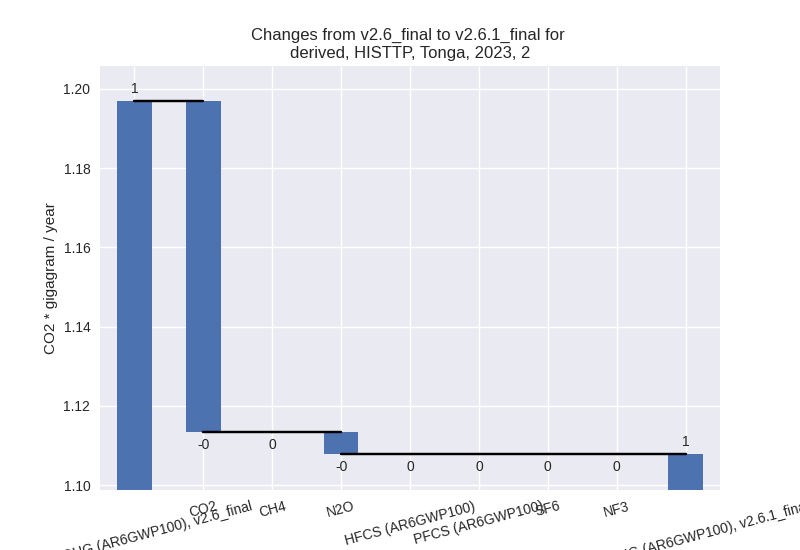
- M.AG: Total sectoral emissions in 2022 are 84.28 Gg CO2 / year which is 27.2% of M.0.EL emissions. 2023 Emissions have changed by -1.1% (-0.94 Gg CO2 / year). 1990-2023 Emissions have changed by -0.3% (-0.24 Gg CO2 / year).
- 4: Total sectoral emissions in 2022 are 37.05 Gg
CO2 / year which is 12.0% of M.0.EL emissions. 2023 Emissions have
changed by 13.4% (4.39 Gg CO2 /
year). 1990-2023 Emissions have changed by 13.9% (3.99 Gg CO2 / year). For 2023 the
changes per gas
are:
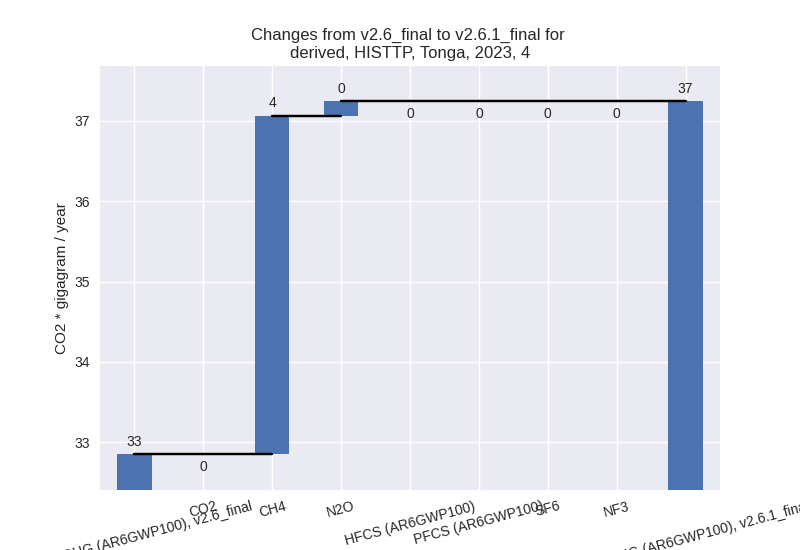
For 1990-2023 the changes per gas are: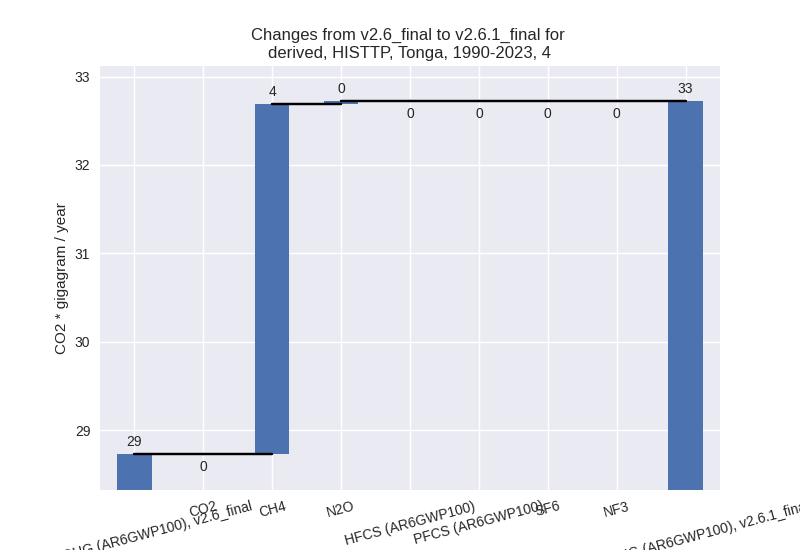
- 5: Total sectoral emissions in 2022 are 1.77 Gg CO2
/ year which is 0.6% of M.0.EL emissions. 2023 Emissions have changed by
28.5% (0.40 Gg CO2 / year).
1990-2023 Emissions have changed by 3.6% (0.05 Gg CO2 / year). For 2023 the
changes per gas
are:
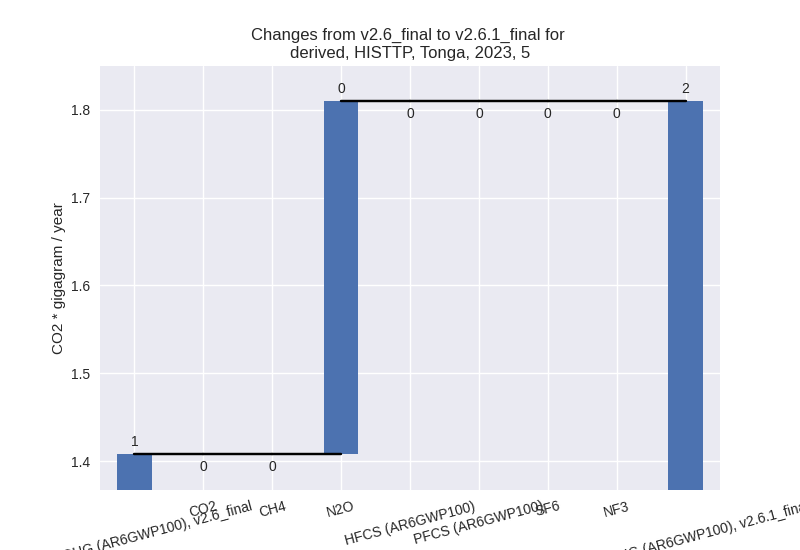
For 1990-2023 the changes per gas are: